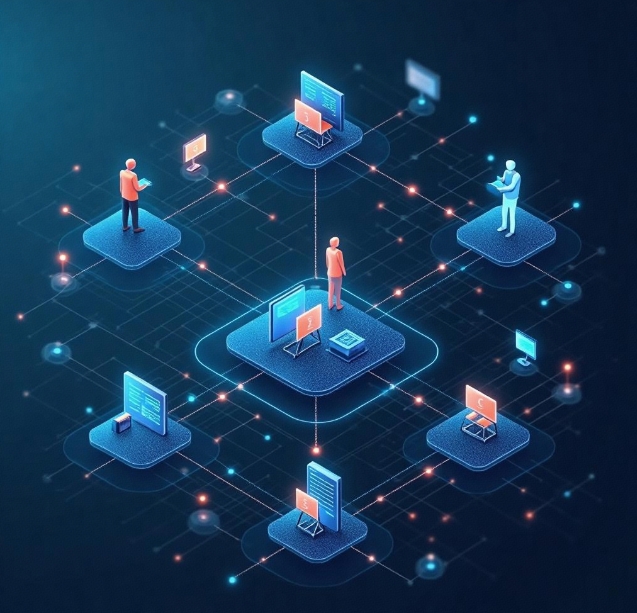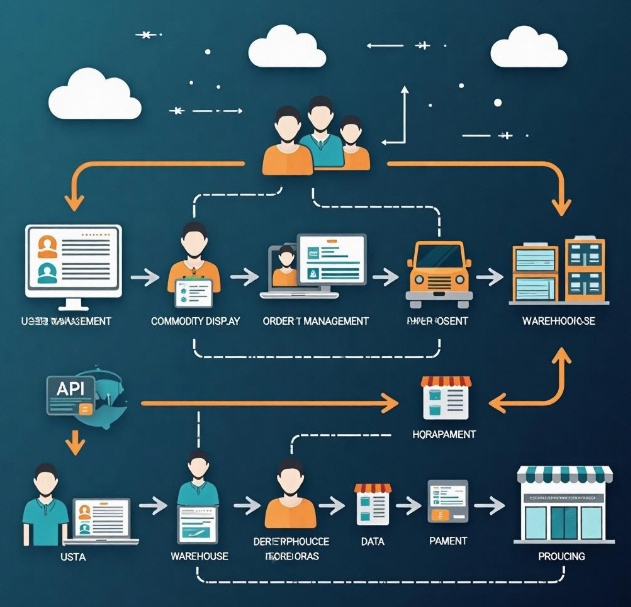Distribution System Development API Integration Guide
- latest articles
- 1.DApp Development & Customization: Merging Diverse Market Needs with User Experience 2.Analysis of the Core Technical System in DApp Project Development 3.How to achieve cross-chain interoperability in Web3 projects? 4.How does the tokenization of points reconstruct the e-commerce ecosystem? 5.How to Set and Track Data Metrics for a Points Mall? 6.What is DApp Development? Core Concepts and Technical Analysis 7.Inventory of commonly used Web3 development tools and usage tips 8.Development of a Distribution System Integrated with Social E-commerce 9.Six Key Steps for Businesses to Build a Points Mall System 10.What is DApp Development? A Comprehensive Guide from Concept to Implementation
- Popular Articles
- 1.Future Trends and Technology Predictions for APP Development in 2025 2.Analysis of the DeFi Ecosystem: How Developers Can Participate in Decentralized Finance Innovation 3.From Zero to One: How PI Mall Revolutionizes the Traditional E-commerce Model 4.DAPP Development | Best Practices for Professional Customization and Rapid Launch 5.Recommended by the Web3 developer community: the most noteworthy forums and resources 6.From Cloud Computing to Computing Power Leasing: Building a Flexible and Scalable Computing Resource Platform 7.Shared Bike System APP: The Convenient Choice in the Era of Smart Travel 8.How to Develop a Successful Douyin Mini Program: Technical Architecture and Best Practices 9.How to Create a Successful Dating App: From Needs Analysis to User Experience Design 10.From Design to Development: The Complete Process of Bringing an APP Idea to Life
With the development of the internet, the distribution model of e-commerce platforms has become increasingly favored by various enterprises and merchants. Distribution systems not only effectively enhance sales channels and expand product market coverage but also attract more agents and partners through incentive mechanisms, promoting the rapid spread of products. In the process of automating distribution systems and achieving data sharing and interoperability, APIs (Application Programming Interfaces), as a core technical means, play a crucial role.
This article will detail the API integration process in distribution system development, helping developers and technical teams better understand the basic concepts of APIs, the integration process, common issues, and best practices.
I. Overview of Distribution Systems
1.1 Definition and Role of Distribution Systems
A distribution system refers to a business model that promotes products or services to end consumers through layers of agents and distributors. In modern e-commerce platforms, distribution systems typically manage different roles such as agents, merchants, and consumers through online platforms and incentivize agents to sell through various rules (such as commission rates, distribution rewards, etc.).
Specifically, the main functions of a distribution system include:
Agent Management: Includes agent registration, approval, tier classification, performance statistics, etc.
Product Management: Displays products available for distribution, sets parameters such as price, inventory, and commission.
Order Management: Tracks order status, including ordering, payment, delivery, returns, and exchanges.
Settlement Management: Calculates agent commissions, handles payments, and settlements.
Data Statistics: Provides sales reports, performance analysis, and other data support.
To achieve these functions, distribution systems often need to share information and exchange data with other systems (such as e-commerce platforms, payment platforms, inventory management systems, etc.), where APIs become particularly important.
1.2 Importance of APIs
APIs serve as the "bridge" for data interaction and function calls between different modules and systems in a distribution system. Through API interfaces, distribution systems can connect with external services such as payment systems, logistics systems, and inventory management systems, thereby achieving business automation, reducing manual intervention, and improving overall efficiency.
II. Basic Process of Distribution System API Integration
2.1 Requirement Analysis and Interface Planning
Before API integration, it is essential to clarify the requirements of the distribution system. This stage involves sorting out business needs, designing data flows, and planning interfaces. Development teams and business departments need to work closely to ensure that the API design meets actual needs and that data transfer between systems is smooth.
1. Determine Interface Functions
API function design should be planned based on business requirements. Common distribution system API interfaces include:
User Management Interface: Used for functions such as user registration, login, and permission verification.
Product Management Interface: Used for adding, modifying, deleting, and querying products.
Order Management Interface: Used for functions such as placing orders, payments, and refunds.
Commission Settlement Interface: Used for calculating and settling agent commissions.
Report Statistics Interface: Used for generating sales reports, performance analysis, etc.
2. Determine Data Format and Transmission Protocol
API data formats are typically JSON or XML, and transmission protocols are commonly HTTP/HTTPS. Depending on the specific system, other suitable protocols such as WebSocket or gRPC can be chosen.
3. Determine API Security Design
When developing APIs, security is a very important consideration. Common security measures include:
Authentication: Verifying the identity of API callers using methods such as OAuth or API keys.
Data Encryption: Encrypting sensitive data to prevent data leaks.
Access Control: Restricting API access based on different role permissions.
2.2 API Development and Documentation Writing
When developing APIs, coding should be done based on the functional requirements outlined in the interface planning. Developers can choose suitable programming languages and frameworks for API development, such as mainstream languages like Java, Python, Node.js, combined with development frameworks like Spring Boot, Django, Express, etc.
1. Interface Documentation Writing
Writing clear and understandable API documentation is an important part of API integration. API documentation is not only a key reference for developers but also facilitates third-party developers in integration. API documentation should include the following:
Interface Description: Detailed introduction to the function, request method, request parameters, return results, etc., of each API interface.
Example Code: Provides common API call examples to help developers understand how to use the interface.
Error Code Explanation: Lists possible error codes and their meanings to help developers troubleshoot issues.
2. Interface Testing
After development is completed, the development team needs to conduct comprehensive testing of the API. Common testing methods include:
Unit Testing: Testing whether individual functional modules are working correctly.
Integration Testing: Testing whether the collaborative work between multiple modules or systems is functioning properly.
Stress Testing: Testing the performance of the API to ensure stable operation under high concurrency.
III. Common Issues in Distribution System API Integration
3.1 Data Synchronization Issues
Distribution systems often need to interact with multiple external systems (such as payment systems, warehousing systems, etc.). Untimely or inaccurate data synchronization can lead to order errors, insufficient inventory, and other problems. To avoid this, the following measures can be taken:
Scheduled Synchronization: Set up scheduled tasks to periodically synchronize data from external systems.
Real-time Synchronization: Update relevant data in real-time when key operations occur (such as placing an order, payment).
Data Validation: Design data validation mechanisms to ensure the accuracy of synchronized data.
3.2 API Call Frequency Limits
Many third-party systems impose limits on API call frequencies. If the call frequency is too high, it may result in system bans or access restrictions. In such cases, developers can adopt the following strategies:
Rate Limiting: Implement rate limiting mechanisms in API requests to avoid exceeding the system's capacity.
Asynchronous Processing: Convert some non-urgent operations (such as report generation, data statistics) to asynchronous processing to reduce the load on synchronous interfaces.
3.3 Data Security and Privacy Issues
Distribution systems involve a large amount of user information and transaction data. During API design and integration, special attention must be paid to data security and privacy protection:
Encrypted Transmission: Use encrypted protocols such as HTTPS to ensure data is not stolen during transmission.
Data Masking: For sensitive data (such as user bank card numbers, ID numbers), masking can be applied to avoid leaks.
Access Control: Strictly control API access permissions to ensure only authorized personnel can call the interfaces.
IV. Best Practices for Distribution System API Integration
4.1 Maintain API Version Management
As business requirements change, API interfaces will be continuously upgraded and adjusted. Therefore, good version management is crucial. Common API version management methods include:
URL Version Control: Include version numbers in the API URL, such as
/v1/,/v2/, etc.Request Header Version Control: Include version information in the HTTP request header, such as
X-API-Version.
4.2 Design a Clear Error Handling Mechanism
A good error handling mechanism can help developers quickly locate and resolve issues. APIs should return standardized error information, such as:
Error code
Error message description
Possible solutions
4.3 Maintain High Availability and Fault Tolerance
Distribution system APIs need to ensure high availability and fault tolerance. The following methods can be used to improve system availability:
Load Balancing: Distribute API request pressure across multiple servers to avoid single points of failure.
Fault Tolerance Design: Incorporate retry mechanisms in API requests to ensure the system can automatically recover during network fluctuations or temporary failures.
V. Conclusion
API integration for distribution systems is a complex process involving multiple aspects, including business requirements, technical implementation, and security protection. Developers need to start from system requirements, carefully design API interfaces, and ensure data accuracy, security, and stability. At the same time, good API documentation and error handling mechanisms can help developers get started quickly and resolve issues. Through reasonable API integration, distribution systems can achieve efficient and automated operations, promoting business development and growth.
We hope this guide provides some useful references for developers to better complete the API integration work for distribution systems.
-

How does the tokenization of points reconstruct the e-commerce ecosystem?
With the continuous advancement of internet technology and the gradual prolifera···
-

How to Set and Track Data Metrics for a Points Mall?
With the rapid development of the e-commerce industry, points malls, as a common···
-

Development of a Distribution System Integrated with Social E-commerce
With the rapid development of internet technology, the e-commerce industry has e···

 Blockchain
Blockchain












